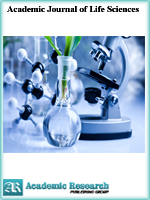Academic Journal of Life Sciences
Online ISSN: 2415-2137
Print ISSN: 2415-5217
Print ISSN: 2415-5217
Quarterly Published (4 Issues Per Year)

Archives
Volume 6 Number 2 February 2020
Phenotypic Correlation of Body Weight and Linear Body Measurements in Muscovy (Cairinia Moschata) and Mallard (Anas Platyrhynchos) Ducks
Authors: Ologbose F. I. ; Mbara S. W.
Pages: 13-17
DOI: doi.org/10.32861/ajls.62.13.17
Abstract
Data on body weight and linear body measurements (LBMs) namely body height (BH), body length (BL), breast circumference (BC), thigh length (TL), bill length (BiL), wing length (WL) and shank length (SL) were taken from 120 ducks (i. e. 60 Muscovy and 60 Mallard ducks) at 4 and 8 weeks of age were analysed to obtain the phenotypic correlation between LBMs and body weight. The value of the pearson’s linear correlation coefficient to determine the level of relationship between the body weight and linear body measurement. This ranged from 0.488 (SL) – 0.996 (BH) and (0.729 (SL) – 0.996 (Bil) in Muscovy and Mallard duck at week 4 respectively. While, at week 8, the value of the pearson’s linear correlation coefficient ranges from 0.126 (Bil) – 0.960 (BL) and 0.735(BC) – 0.978 (BH) respectively. This positive and mostly significantly phenotypic relationship between the body weight and linear body measurements indicates that an improvement in one trait could leads to an improvement in the other. Correlation coefficients indicate the strength of a linear relation between traits and thus provide useful information about the traits involved for the purpose of breeding and improvement plan. This shows that favourable relationships exist among traits that have higher correlation coefficients, it further explains that such traits could be collectively included in the selection index to achieve positive phenotypic progress.
Assessment of in Vivo Antimicrobials Effect of some Medicinal Plants Seeds on Broilers Meat Keeping Quality
Authors: Mohamed Elkhatim ; Abdelmageed Hyder O. Abdalla ; Omer H. Arabi ; Babiker M. S. ; Abdel Moneim E. Sulieman
Pages: 8-12
DOI: doi.org/10.32861/ajls.62.8.12
Abstract
The aim of the study is to evaluate the in vivo antimicrobial effect of some natural products, that include seeds of: Black cumin Fenugreek, Moringa olefera, Clitoria ternatea, Sunflower and Vit E on broiler meat keeping quality. One hundred and five one day old male chicks were used. They were allotted to 7 treatments with 3 replications each in CRD design .The chicks were fed balanced rations supplemented with tested seeds and Vit E. In vivo antimicrobial effects of tested seeds were measured using the serial dilution method on chickens breast samples at fresh, - 4oC and at – 20oC for 30 days. The tested seeds had an in vitro antifungal and antimicrobial effect on Gram + ve and Gram -ve bacteria. The in vivo antimicrobial effects of tested seeds showed no significant at fresh and -20oC storage conditions; however, there was a significant difference among treatments at – 4oC-storage condition. Nevertheless, there was a significant difference among storage conditions. Generally, the results demonstrated that the tested seeds can be used as an in vitro antimicrobial natural source.



